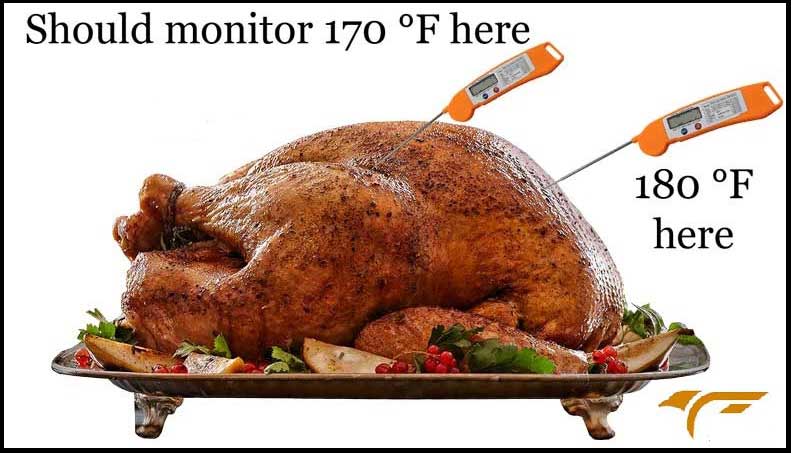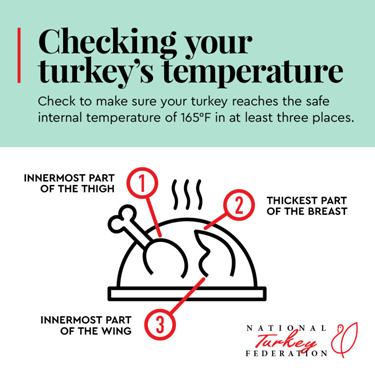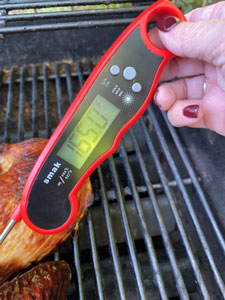Cooking the perfect turkey can seem like a daunting task, especially when it comes to getting the temperature just right. Using a meat thermometer takes the guesswork out of determining doneness and ensures your turkey is cooked through without drying out But in order to get an accurate reading, you need to know exactly where to insert the thermometer probe This article will explain the best practices for thermometer placement so you can enjoy tender, juicy turkey every time.
Why Temperature Matters
The only way to definitively tell when your turkey is fully cooked and safe to eat is to use a food thermometer. Appearance and cooking times can be misleading, since factors like the shape and size of the bird, your oven’s accuracy, and whether or not the turkey was stuffed can all affect cooking. The one constant is the internal temperature, which needs to reach a minimum of 165°F throughout the meat for it to be considered safe and ready to eat.
Undercooked turkey can pose a dangerous foodborne illness risk, while overcooked meat dries out quickly and becomes tough. Neither makes for an appetizing centerpiece to your holiday table But hitting that 165°F sweet spot means your turkey will turn out moist, tender and delicious. A good thermometer helps you nail it every time
Choosing The Right Thermometer
The two main types of thermometers designed for taking internal temperatures are instant-read and leave-in/oven-safe models. Here’s a quick rundown of their differences:
-
Instant-read thermometers provide quick, accurate temperature readings but are not intended to remain inside the turkey while it cooks. You’ll insert the probe once the estimated cook time is almost up, allow 15-20 seconds for the digital display to stabilize, then remove and clean it immediately.
-
Leave-in thermometers have an oven-safe probe on a wire that remains inserted in the meat during the entire cooking time, This lets you monitor the internal temp without repeatedly opening the oven The base unit stays outside the oven and has an easy-to-read display
Either type will work well, so opt for what best fits your budget and cooking style. The most important thing is that your thermometer is properly calibrated for accuracy. An inaccurate reading can lead to unsafe or over/undercooked meat.
Digital thermometers tend to be the most precise and easy to use. If you go with a dial thermometer, be sure to test and recalibrate it before each use. Analog thermometers can lose accuracy over time.
Proper Thermometer Placement
To effectively measure the internal temperature throughout the turkey, you’ll need to check multiple areas:
- Thickest part of the breast
- Innermost portion of the thigh
- Innermost portion of the wing
With an instant-read thermometer, insert the probe into each area, one at a time, for 15-20 seconds to allow the reading to stabilize. Be careful not to hit any bones, and don’t let the probe touch the pan.
For a leave-in thermometer, insert the probe horizontally into the thickest part of the breast when first putting the raw turkey in the oven. Look for the area with the most even thickness of meat above and below. The tip should reach the deepest section without touching any cavity walls. Secure the probe and wire firmly to keep it in position.
If you’re stuffing your turkey, always check the center of the stuffing as well. It needs to reach 165°F to eliminate bacteria that can migrate from the stuffing into the meat.
Doneness Temperatures
Here are the recommended safe internal temperatures:
- Whole turkey: 165°F throughout, including the breast, thighs, and wings
- Turkey breast: 165°F
- Stuffing: 165°F
- Thighs and wings: 175°F – 180°F will be juicier
For optimal moisture, cook your turkey just until the breast reaches 165°F, even if the thighs and wings register slightly lower. The temperature will continue rising as the turkey rests. The thighs and wings can better withstand higher temperatures without drying out.
If using a pop-up thermometer, be sure to verify it against an instant-read. Pop-ups can sometimes activate prematurely or fail to pop at all. Don’t rely solely on their accuracy.
Handling Your Thermometer Safely
Proper thermometer hygiene is important to avoid cross contamination. Follow these steps:
- Wash the stem thoroughly with hot, soapy water before and after each use.
- Sanitize by dipping the stem in rubbing alcohol or a diluted bleach solution.
- Never insert the thermometer into multiple foods without washing and sanitizing between uses.
- Store thermometers in a clean container, not in a drawer where the stem could pick up bacteria.
With the right techniques, checking turkey temperature is easy and hassle-free. Trust in your thermometer, and it will lead you to perfect results every time. Crispy skin, juicy meat, and foolproof food safety are worth investing in a good thermometer. It takes the guesswork and stress out of roasting this holiday bird to perfection.

Where to Put the Thermometer in a Turkey

An important part of using any thermometer is the proper placement in the turkey. Unsure of where to put the thermometer in a turkey? Here are few tips to keep in mind:
- When preparing a whole turkey, insert the thermometer into the thickest portion of the turkey breast, the innermost portion of thigh and the innermost portion of the wing.
- Make sure the thermometer does not touch bone, gristle or the pan.
- When inserting the thermometer in a turkey breast or ground turkey patty, insert it from the side. The thermometer is easier to read and more accurate than when inserted from the top.
The internal temperature of your turkey (and any stuffing) should always reach 165°F.

According to the U.S. Food and Drug Administration, the percentage of consumers who own food thermometers has increased from 49 percent in 1998 to 70 percent in 2010. Both the National Turkey Federation and USDA recommend using a meat thermometer to ensure a delicious and safe meal.
Accurate temperatures, both in the oven and the turkey are important for quality and safety. A meat thermometer is a cook’s best friend when it comes time to prepare a meal.
Meat thermometers that can be calibrated for accuracy and instant-read/digital thermometers are our preferred choices. These types of thermometers are available at grocery, kitchen and hardware stores.
Don’t forget about your oven’s temperature! Check the oven thermostat and oven temperature to verify the oven setting. Recalibrate if necessary – a 25°F variation can make a 5 percent difference in cooked turkey yield. An oven that is too hot will dry and shrink the bird.
Check out USDA’s resource for more information on proper cooking temperatures.
This should be inserted into the turkey at the beginning of the cooking time and remain inserted in the bird while cooking. The temperature indicator will rise slowly as the turkey cooks. An oven-proof thermometer is ideal for the whole turkey and the turkey breast.
These thermometers enable you to measure the internal temperatures of meat with the most accurate reading in the quickest time possible. They are not designed to stay in the food during cooking. If you use this type, pull the turkey out of the oven far enough to insert the stem about 2 1/2 inches into the thickest part of the meat, but not touching bone or the roasting pan.
The sensing tip is a small indentation located about 1 1/2 inches from the end of the stem and must be fully inserted into the bird. (Look for a tiny dimple on the stem.) The temperature should register in about 15-20 seconds. Wipe with a sanitizer after each use and before the next use.
These are commonly found in the whole turkey and turkey breast. The “pop-up” thermometer device indicates the turkey has reached the final temperature for safety and doneness. Experts suggest the temperature be verified with a conventional thermometer.
USDA has a full listing of the various types of food thermometers available.
Food thermometers should be washed following use with hot soapy water and sanitized. Most thermometers, particularly digital and instant-read varieties, should not be immersed in water.
There are several ways to sanitize your thermometer:
- Use an alcohol swab to wipe the stem.
- Use a food-safe sanitizing solution, such as chlorine bleach and water, diluted according to the directions on the bottle, by holding it in the diluted mixture for a minimum of 10 seconds.
- Hold the stem in boiling water for no less than 30 seconds.
If using alcohol or a cleaning solution, make sure to wash the stem with soap and hot water to remove any residue.
How to Insert a Meat Thermometer into Turkey
FAQ
Where is the best place to put a leave in thermometer in a turkey?
Where is the best place to check the temperature of a turkey?
